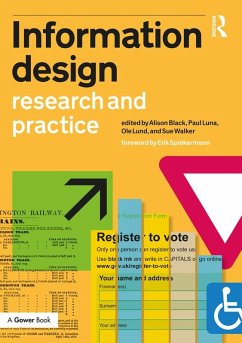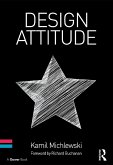Information Design (eBook, ePUB)
Research and Practice
Redaktion: Black, Alison; Walker, Sue; Lund, Ole; Luna, Paul
74,95 €
74,95 €
inkl. MwSt.
Sofort per Download lieferbar

37 °P sammeln
74,95 €
Als Download kaufen

74,95 €
inkl. MwSt.
Sofort per Download lieferbar

37 °P sammeln
Jetzt verschenken
Alle Infos zum eBook verschenken
74,95 €
inkl. MwSt.
Sofort per Download lieferbar
Alle Infos zum eBook verschenken

37 °P sammeln
Information Design (eBook, ePUB)
Research and Practice
Redaktion: Black, Alison; Walker, Sue; Lund, Ole; Luna, Paul
- Format: ePub
- Merkliste
- Auf die Merkliste
- Bewerten Bewerten
- Teilen
- Produkt teilen
- Produkterinnerung
- Produkterinnerung

Bitte loggen Sie sich zunächst in Ihr Kundenkonto ein oder registrieren Sie sich bei
bücher.de, um das eBook-Abo tolino select nutzen zu können.
Hier können Sie sich einloggen
Hier können Sie sich einloggen
Sie sind bereits eingeloggt. Klicken Sie auf 2. tolino select Abo, um fortzufahren.

Bitte loggen Sie sich zunächst in Ihr Kundenkonto ein oder registrieren Sie sich bei bücher.de, um das eBook-Abo tolino select nutzen zu können.
Information Design provides citizens, business and government with a means of presenting and interacting with complex information.
- Geräte: eReader
- mit Kopierschutz
- eBook Hilfe
- Größe: 17.55MB
Andere Kunden interessierten sich auch für
![Longer Lasting Products (eBook, ePUB) Longer Lasting Products (eBook, ePUB)]() Longer Lasting Products (eBook, ePUB)40,95 €
Longer Lasting Products (eBook, ePUB)40,95 €![Design Attitude (eBook, ePUB) Design Attitude (eBook, ePUB)]() Kamil MichlewskiDesign Attitude (eBook, ePUB)59,95 €
Kamil MichlewskiDesign Attitude (eBook, ePUB)59,95 €![Transforming Public Services by Design (eBook, ePUB) Transforming Public Services by Design (eBook, ePUB)]() Sabine JungingerTransforming Public Services by Design (eBook, ePUB)36,95 €
Sabine JungingerTransforming Public Services by Design (eBook, ePUB)36,95 €![Sustainable Product Design and Development (eBook, ePUB) Sustainable Product Design and Development (eBook, ePUB)]() Anoop DesaiSustainable Product Design and Development (eBook, ePUB)49,95 €
Anoop DesaiSustainable Product Design and Development (eBook, ePUB)49,95 €![Applied Design Research (eBook, ePUB) Applied Design Research (eBook, ePUB)]() Applied Design Research (eBook, ePUB)0,00 €
Applied Design Research (eBook, ePUB)0,00 €![Applied Systems Analysis (eBook, ePUB) Applied Systems Analysis (eBook, ePUB)]() F. P. TarasenkoApplied Systems Analysis (eBook, ePUB)48,95 €
F. P. TarasenkoApplied Systems Analysis (eBook, ePUB)48,95 €![Reinventing Manufacturing and Business Processes Through Artificial Intelligence (eBook, ePUB) Reinventing Manufacturing and Business Processes Through Artificial Intelligence (eBook, ePUB)]() Reinventing Manufacturing and Business Processes Through Artificial Intelligence (eBook, ePUB)48,95 €
Reinventing Manufacturing and Business Processes Through Artificial Intelligence (eBook, ePUB)48,95 €-
-
-
Information Design provides citizens, business and government with a means of presenting and interacting with complex information.
Dieser Download kann aus rechtlichen Gründen nur mit Rechnungsadresse in A, B, BG, CY, CZ, D, DK, EW, E, FIN, F, GR, HR, H, IRL, I, LT, L, LR, M, NL, PL, P, R, S, SLO, SK ausgeliefert werden.
Produktdetails
- Produktdetails
- Verlag: Taylor & Francis eBooks
- Seitenzahl: 766
- Erscheinungstermin: 12. Januar 2017
- Englisch
- ISBN-13: 9781317125280
- Artikelnr.: 47511133
- Verlag: Taylor & Francis eBooks
- Seitenzahl: 766
- Erscheinungstermin: 12. Januar 2017
- Englisch
- ISBN-13: 9781317125280
- Artikelnr.: 47511133
- Herstellerkennzeichnung Die Herstellerinformationen sind derzeit nicht verfügbar.
Professor Alison Black is Professor of User-Centred Design and directs the Centre for Information Design Research. A psychologist by training she has always worked with designers, both in industry and academia. Her research focuses on public communication in health settings and on the presentation of weather and extreme events forecasting. Professor Paul Luna both researches and designs complex texts. He designed the last two editions of the Shorter Oxford English Dictionary, has written on the relationship between typography and lexicography, and has also published a study of the typography of Samuel Johnson's Dictionary. Paul is co-editor of the Department of Typography & Graphic Communication's publication Typography Papers. Ole Lund is Associate Professor in the Department of Design at the Norwegian University of Science and Technology, and a former Programme Director for the MA Information Design at the University of Reading. He has a special interest in the history, theory and practice of typography, i.e. design for reading. Professor Sue Walker is an academic with an interest in typography and language, the design of learning materials for young children, and information design in public services. She is a partner in the information design consultancy, Text Matters, and was one of the principal researchers on the AHRC-funded 'Isotype revisited' project. The Department of Typography & Graphic Communication at University of Reading has an outstanding and international reputation for teaching and research in information design. Graduates of its undergraduate, masters and doctoral programmes have helped shape information design across the public and private sector, working in areas as diverse as overseas aid, through urban transport planning, to mobile phone interface design. The Department's Centre for Information Design Research brings together expertise in writing, graphic design, interaction design and psychology, carrying out projects in partnership with users of information design, such as health providers, government agencies and the insurance industry.
Part 1 Chapter 1. Early visualizations of historical time Chapter 2. Images
of time Chapter 3. William Playfair and the invention of statistical graphs
Chapter 4. Ship navigation Chapter 5. Technical and scientific illustration
Chapter 6. The lessons of Isotype for information design Chapter 7. Marie
Neurath: designing information books for young people Chapter 8. Future,
Fortune, and the graphic design of information Chapter 9. Some documents
for a history of information design Chapter 10. Moral visualizations
Part 2 Chapter 11. Graphic literacies for a digital age Chapter 12. Visual
rhetoric in information design Chapter 13. Multimodality and genre Chapter
14. Interactive information graphics Chapter 15. Social and cultural
aspects of visual conventions in information Chapter 16. Textual reading on
paper and screens Chapter 17. Applying science to design
Part 3 Chapter 18. Does my symbol sign work? Chapter 19. Icons as carriers
of information Chapter 20. Warning design Chapter 21. Diagrams Chapter 22.
Designing static and animated diagrams for modern learning materials
Chapter 23. Designing auditory alarms Chapter 24. Design challenges in
helping older adults use digital tablets Chapter 25. On-screen colour
contrast for visually impaired readers Chapter 26. Contrast set labelling
Chapter 27. Gestalt principles Chapter 28. Information design research
methods Chapter 29. Methods for evaluating information design Chapter 30.
Public information documents
Part 4 Chapter 31. Choosing type for information design Chapter 32.
Indexing and information design Chapter 33. When to use numeric tables and
why Chapter 34. Wayfinding perspectives Chapter 35. Designing for
wayfinding Chapter 36. The problem of 'straight ahead' signage Chapter 37.
Park at your peril Chapter 38. Indoor digital wayfinding Chapter 39.
Visualizing storyworlds Chapter 40. Exhibitions for learning Chapter 41.
Form follows user follows form Chapter 42. Information design & value
Chapter 43. The LUNAtic approach to information design Chapter 44.
Information design as a (r)evolutionary educational tool Chapter 45. Design
+ medical collaboration Chapter 46. Developing persuasive health campaign
messages Chapter 47. Information design in medicine package leaflets
Chapter 48. Using animation to help communication in e-PILs in Brazil
Chapter 49. Medical information design and its legislation
of time Chapter 3. William Playfair and the invention of statistical graphs
Chapter 4. Ship navigation Chapter 5. Technical and scientific illustration
Chapter 6. The lessons of Isotype for information design Chapter 7. Marie
Neurath: designing information books for young people Chapter 8. Future,
Fortune, and the graphic design of information Chapter 9. Some documents
for a history of information design Chapter 10. Moral visualizations
Part 2 Chapter 11. Graphic literacies for a digital age Chapter 12. Visual
rhetoric in information design Chapter 13. Multimodality and genre Chapter
14. Interactive information graphics Chapter 15. Social and cultural
aspects of visual conventions in information Chapter 16. Textual reading on
paper and screens Chapter 17. Applying science to design
Part 3 Chapter 18. Does my symbol sign work? Chapter 19. Icons as carriers
of information Chapter 20. Warning design Chapter 21. Diagrams Chapter 22.
Designing static and animated diagrams for modern learning materials
Chapter 23. Designing auditory alarms Chapter 24. Design challenges in
helping older adults use digital tablets Chapter 25. On-screen colour
contrast for visually impaired readers Chapter 26. Contrast set labelling
Chapter 27. Gestalt principles Chapter 28. Information design research
methods Chapter 29. Methods for evaluating information design Chapter 30.
Public information documents
Part 4 Chapter 31. Choosing type for information design Chapter 32.
Indexing and information design Chapter 33. When to use numeric tables and
why Chapter 34. Wayfinding perspectives Chapter 35. Designing for
wayfinding Chapter 36. The problem of 'straight ahead' signage Chapter 37.
Park at your peril Chapter 38. Indoor digital wayfinding Chapter 39.
Visualizing storyworlds Chapter 40. Exhibitions for learning Chapter 41.
Form follows user follows form Chapter 42. Information design & value
Chapter 43. The LUNAtic approach to information design Chapter 44.
Information design as a (r)evolutionary educational tool Chapter 45. Design
+ medical collaboration Chapter 46. Developing persuasive health campaign
messages Chapter 47. Information design in medicine package leaflets
Chapter 48. Using animation to help communication in e-PILs in Brazil
Chapter 49. Medical information design and its legislation
Part 1 Chapter 1. Early visualizations of historical time Chapter 2. Images
of time Chapter 3. William Playfair and the invention of statistical graphs
Chapter 4. Ship navigation Chapter 5. Technical and scientific illustration
Chapter 6. The lessons of Isotype for information design Chapter 7. Marie
Neurath: designing information books for young people Chapter 8. Future,
Fortune, and the graphic design of information Chapter 9. Some documents
for a history of information design Chapter 10. Moral visualizations
Part 2 Chapter 11. Graphic literacies for a digital age Chapter 12. Visual
rhetoric in information design Chapter 13. Multimodality and genre Chapter
14. Interactive information graphics Chapter 15. Social and cultural
aspects of visual conventions in information Chapter 16. Textual reading on
paper and screens Chapter 17. Applying science to design
Part 3 Chapter 18. Does my symbol sign work? Chapter 19. Icons as carriers
of information Chapter 20. Warning design Chapter 21. Diagrams Chapter 22.
Designing static and animated diagrams for modern learning materials
Chapter 23. Designing auditory alarms Chapter 24. Design challenges in
helping older adults use digital tablets Chapter 25. On-screen colour
contrast for visually impaired readers Chapter 26. Contrast set labelling
Chapter 27. Gestalt principles Chapter 28. Information design research
methods Chapter 29. Methods for evaluating information design Chapter 30.
Public information documents
Part 4 Chapter 31. Choosing type for information design Chapter 32.
Indexing and information design Chapter 33. When to use numeric tables and
why Chapter 34. Wayfinding perspectives Chapter 35. Designing for
wayfinding Chapter 36. The problem of 'straight ahead' signage Chapter 37.
Park at your peril Chapter 38. Indoor digital wayfinding Chapter 39.
Visualizing storyworlds Chapter 40. Exhibitions for learning Chapter 41.
Form follows user follows form Chapter 42. Information design & value
Chapter 43. The LUNAtic approach to information design Chapter 44.
Information design as a (r)evolutionary educational tool Chapter 45. Design
+ medical collaboration Chapter 46. Developing persuasive health campaign
messages Chapter 47. Information design in medicine package leaflets
Chapter 48. Using animation to help communication in e-PILs in Brazil
Chapter 49. Medical information design and its legislation
of time Chapter 3. William Playfair and the invention of statistical graphs
Chapter 4. Ship navigation Chapter 5. Technical and scientific illustration
Chapter 6. The lessons of Isotype for information design Chapter 7. Marie
Neurath: designing information books for young people Chapter 8. Future,
Fortune, and the graphic design of information Chapter 9. Some documents
for a history of information design Chapter 10. Moral visualizations
Part 2 Chapter 11. Graphic literacies for a digital age Chapter 12. Visual
rhetoric in information design Chapter 13. Multimodality and genre Chapter
14. Interactive information graphics Chapter 15. Social and cultural
aspects of visual conventions in information Chapter 16. Textual reading on
paper and screens Chapter 17. Applying science to design
Part 3 Chapter 18. Does my symbol sign work? Chapter 19. Icons as carriers
of information Chapter 20. Warning design Chapter 21. Diagrams Chapter 22.
Designing static and animated diagrams for modern learning materials
Chapter 23. Designing auditory alarms Chapter 24. Design challenges in
helping older adults use digital tablets Chapter 25. On-screen colour
contrast for visually impaired readers Chapter 26. Contrast set labelling
Chapter 27. Gestalt principles Chapter 28. Information design research
methods Chapter 29. Methods for evaluating information design Chapter 30.
Public information documents
Part 4 Chapter 31. Choosing type for information design Chapter 32.
Indexing and information design Chapter 33. When to use numeric tables and
why Chapter 34. Wayfinding perspectives Chapter 35. Designing for
wayfinding Chapter 36. The problem of 'straight ahead' signage Chapter 37.
Park at your peril Chapter 38. Indoor digital wayfinding Chapter 39.
Visualizing storyworlds Chapter 40. Exhibitions for learning Chapter 41.
Form follows user follows form Chapter 42. Information design & value
Chapter 43. The LUNAtic approach to information design Chapter 44.
Information design as a (r)evolutionary educational tool Chapter 45. Design
+ medical collaboration Chapter 46. Developing persuasive health campaign
messages Chapter 47. Information design in medicine package leaflets
Chapter 48. Using animation to help communication in e-PILs in Brazil
Chapter 49. Medical information design and its legislation







